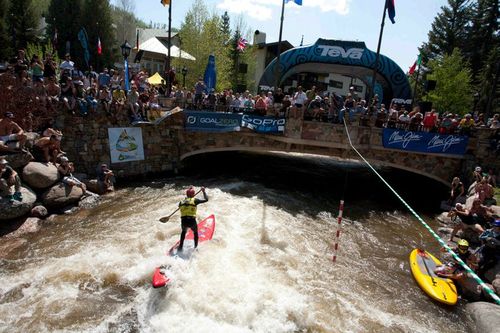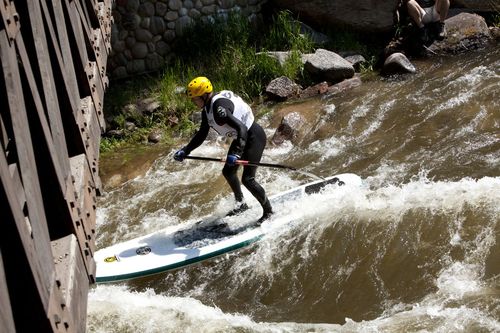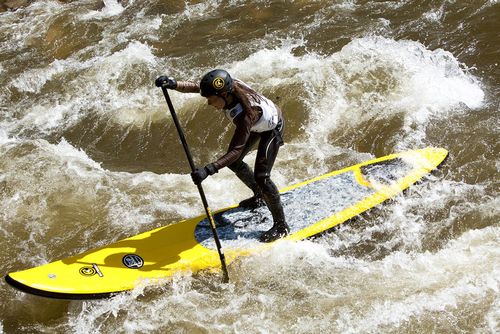
(Noa Ginella on his way to 1st place in the SUP cross.)
Last week I went to the�� in Vail, Colorado, to standup paddleboard in whitewater rapids. It’s hard to explain why whitewater SUPing is so much fun, but it is a really good time. Just like surfing, mountain biking, sailing, good sex, or any other dynamic way to play, a lot of the joy comes from interacting with an ever-changing environment. In whitewater you’re always moving, even when you fall.
On my first run I spent more time in the water pinging off rocks than on my board paddling. My second run down the same four-mile course was better. I only fell once, and by the end of the week I was taking other people on their first runs, including kayaking gurus Kyle and Turin Dickman, from �����ԹϺ��� magazine. As much as I'd like to believe my progression was due to some natural ability, it was really largely because of the incredible advice and support received from other paddlers, especially the crew from and .
If you have the right equipment and gain some basic river knowledge, it’s easy to learn how to SUP in whitewater. For most people, it takes a bit longer than learning how to SUP on flat water, but it is much easier than learning how to SUP in the surf. Once you get the hang of it, you sometimes feel like a fighter pilot flying through a twisting canyon, watching the riverbanks on each side whiz by as you dodge rocks and obstacles. You gotta read the patterns of turbulence and contours on the surface of the water to find the fastest current and to avoid the rocks, drops, strainers, or other obstructions waiting to take you out. ��
At the Teva games the SUP crew was a unique mix of kayakers and surfers. Even to the untrained eye it was easy to tell them apart. Everyone wore PFDs and helmets, but surfers also wore wetsuits and surfing booties while the kayakers tended to wear as much gear as possible: boardshorts over their wetsuits, paddle jackets, knives, boots, shoes, knee pads, shin guards—you name it. Kayakers definitely dig their gear. In retrospect I wouldn’t have minded wearing shin guards…
But that’s one of the cool things about whitewater SUPing: it brings kayakers, surfers, and new paddlers together into a tight-knit mix of diverse cultures and style. Experienced kayakers say they enjoy whitewater SUPing because it lets them experience familiar stretches of rapids from an entirely new perspective—it makes otherwise easy stretches challenging and fun again. Surfers like it because it’s a fun, new, challenging way to ride. The camaraderie among paddlers is legendary. Aloha is aloha whether the water is salty or not.

(Ryan Levinson mid way through the sprint race)
were by far the boards of choice at Teva. These boards are light, durable, affordable, and have exactly the right amount of flex to help get through the most turbulent sections. dominated the event, winning first place in almost every division of every race. Standout paddlers included first-time racer Mariko Strickland from Kauai, defending champion Noa Ginella from Oahu, and whitewater kayak legend Charlie Macarthur from Colorado.
As for being an accessible sport for people with physical disabilities, I think most people with amputations and many people with neuromuscular disorders could adapt currently available equipment without much difficulty. People with spinal cord injuries, moderate to severely progressed neuromuscular disabilities, and other similar conditions may need to adapt their equipment and technique a bit more, but rivers always flow downstream;
The rivers are flowing NOW, welcoming you to jump in and go with the flow. Why not grab some friends, hook up with an outfitter, and give whitewater standup paddling a try?
Life is not a dress rehearsal, get out there and discover for yourself what whitewater standup paddling has to offer!

(Mariko Strickland)
��
When Ryan Levinson was 24 years old, the San Diego-based athlete was diagnosed with an incurable and progressive form of muscular dystrophy known as FSHD. Doctors told him strenuous exercise would worsen his condition. He didn’t listen. Instead, the now 38-year-old continued doing what he loved: sailing, kiteboarding, diving, kayaking, paddleboarding, and surfing. Last December, we named Levinson our Reader of the Year and Chief Inspiration Officer for 2011. You can read his blog posts here.
All images courtesy of and